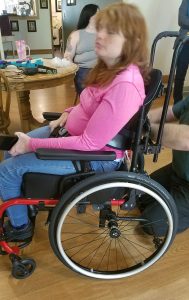Amanda “Rocks” Her Wheelchair for a Walk – an interview with Tamara Kittelson-Aldred
Michelle L. Lange, OTR/L, ATP/SMS
Updated 2/7/2024
Tamara Kittelson-Aldred, M.S., OTR/L, ATP/SMS is an Occupational Therapist in Montana (at the time of this interview) who has been practicing for more than 40 years! She has been using Dynamic Seating with the clients she serves for 10 – 15 years now. Tamara and I talked about her experiences with Dynamic Seating, particularly with one of her clients, Amanda.

Amanda
Tamara, tell me about Amanda
Amanda is now 28 years old, though Tamara has known her since she was an infant. Amanda lives in Missoula, MT and has spastic diplegic cerebral palsy and is legally blind. She currently lives in a group home.
How long has Amanda been using Dynamic Seating?
Amanda has been using a Seating Dynamics Dynamic Rocker Back interface (DRBi) on her manual wheelchair for about 6 years now. She is getting a new manual wheelchair soon, so we also ordered a new DRBi.
How did you first decide to pursue Dynamic Seating for Amanda?
Amanda likes to rock. She tends to lean forward and then forcefully throw herself back in the manual wheelchair. She was at risk of tipping the wheelchair over completely. Her forceful movements would move the wheelchair across the floor if the wheel locks were not engaged. When the wheel locks were engaged, the wheelchair would ‘walk’ across the room as a result of her movements, taking small hops with each movement of her trunk.
Why do you think Amanda rocks in her wheelchair?
Tamara believes that Amanda, and many other people with significant visual impairments, tend to seek out sensory input. Amanda rocks forward and back to obtain this vestibular input.
What benefits have you seen in using the Dynamic Seating?
Amanda is less agitated and more alert when she is able to move. The wheelchair is no longer at risk of tipping over and no longer ‘walks’ across the room when the wheel locks are engaged.
What Clinical Indicators do you look for when considering Dynamic Seating?
Tamara often considers Dynamic Seating with clients who have a lot of extensor tone or who rock and bang in their current static seating system. This may include clients with cerebral palsy and intellectual disabilities, though she considers the clinical presentation, more so than the diagnosis.
Tamara prefers the Dynamic Rocker Back interface as it is durable, it is easy to latch/unlatch, and the pivot point is in an optimal placement to maintain pelvic posture during movement.
According to Tamara, “Dynamic Seating is life changing for people who need it.”
Thanks Tamara, for your expertise and how YOU are changing people’s lives!
More about Amanda: Full Case Study | Video
